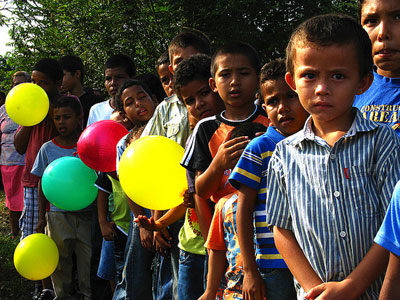Demand for Care Is a Challenge for Social Protection
Systems in Latin America
Photo: Orban López Cruz, Flickr
Care is a welfare issue that affects social development and economic growth. Nevertheless, providing and receiving care is not always guaranteed, and this can become a source of inequality.
Except for a few exceptions, the issue of care has not been placed high on the public policy agenda of the region’s countries, according to Sandra Huenchuan in the study “Health protection in the framework of population dynamics and rights” published in issue N° 100 of the series Población y Desarrollo of the Population Division of ECLAC (CELADE).
The current care burden in the region is concentrated on the child population, whereas in future the bulk of demand will come from older adults and people with some health-related disability.
The number of people with moderate to severe dependency requiring periodical care is expected to double in Latin America between 2000 and 2050, rising from 23 million to 50 million. At present, these are people aged between 15 and 59, but by 2050 it is estimated that half of the dependent population will be aged 60 or over.
According to the study, however, “the demographic opportunity to have carers in the region will be limited in the period 2000-2050”. There will not be enough people to have one carer for every individual who needs help.
“In the region’s countries, the general and specific regulatory frameworks and the range of social programmes relating to protecting children, older adults and dependents all show that the risks associated with care are increasingly concentrated on the family”, states Huenchuan. The burden falls especially on women, irrespective of their age.
This situation “increases the vulnerability of people who need care and of those who provide assistance”, and this is because of the unequal distribution of resources based on family or social origin.
In order to provide immediate and long-term responses to this problem, countries need to reorient their social protection systems around the following three principles: gender and socio-economic “equality”; “universality” of policies and programmes; and “solidarity” among generations.
The study projects different scenarios for some of the region’s countries between 2000 and 2050, based on a proxy measurement known as the “dependency ratio”, in other words the number of individuals with care needs for every 100 potential carers.
Although Cuba began the decade of 2000 with a care burden below the regional average (due to the fall in child population), since 2010 the figure has been climbing rapidly, and this is expected to intensify from 2040 when the country will face care demands from older adults (who will account for almost 60% of the total care burden by 2050).
In Chile, care demand will not vary greatly between 2010 and 2030, but this will begin to rise again and exceed the regional average after that point due to population ageing. In 2050, the care burden of those under the age of 12 will represent 57% of the total, while for those aged 75 and above the figure is 43%.
In Mexico, the dependency ratio will fall until about 2030, when it will begin to climb again. By 2050, the care burden for children will remain higher than for older adults.
In 2010, Guatemala’s care burden was much higher than the regional average (58 people for every 100 potential carers), and this is expected to continue until 2050, mainly because of the demand from the child population. The need for childhood care will remain constant until 2050, when it will represent over 86% of the total burden.
As a result of demographic transition, most countries would have the opportunity to undertake institutional, policy and practical changes to tackle the various demands of the health sector and care sphere, taking due account of changes in families and the role of women, according to the conclusions of Huenchuan.
More IN FOCUS
Logistical
infrastructure of ports could become the “bottleneck” of Latin American growth
Second seminar on telemedicine held in Venezuela
The sun - renewable energy with great potential for Latin America and the Caribbean
ECLAC reveals offices renovated following the earthquake in
2010
| The number of people with moderate to severe dependency requiring periodical care is expected to double in Latin America between 2000 and 2050, rising from 23 million to 50 million. | |
| The current care burden in the region is concentrated on the child population, whereas in
future the bulk of demand will come from older adults and people with some health-related
disability. |
|
